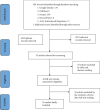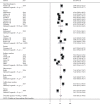Prevalence of Self-Reported Work-Related Lower Back Pain and Its Associated Factors in Ethiopia: A Systematic Review and Meta-Analysis
- PMID: 34603457
- PMCID: PMC8486508
- DOI: 10.1155/2021/6633271
Prevalence of Self-Reported Work-Related Lower Back Pain and Its Associated Factors in Ethiopia: A Systematic Review and Meta-Analysis
Abstract
Introduction: Low back pain is the commonest musculoskeletal disorder affecting every socioeconomic group of the world's population. The lifetime risk of developing low back pain is about 60%-80%. The pooled prevalence and associated factors of low back pain have not yet been determined in Ethiopia. Thus, this study was aimed at assessing the overall prevalence of low back pain and its associated factors in Ethiopia.
Methods: A systematic search of PubMed, Scopus, Science Direct, and Google Scholar for observational studies reporting data on the prevalence and associated factors of low back pain was conducted. Relevant data were extracted with a standardized data extraction excel form. Stata 14 was employed for the meta-analysis. Heterogeneity was assessed by Cochran's Q test and I 2 values of a forest plot. Publication bias was checked using a funnel plot and Egger's test. A random-effects model was used in the analysis.
Result: A total of thirty-two studies were included for the systematic review. Twenty-four and sixteen studies were used to pool the overall low back pain prevalence and associated factors, respectively. The overall pooled annual prevalence of low back pain in Ethiopia was estimated to be 54.05% (95% CI: 48.14-59.96). Age, sex, body mass index, work experience, working hours, lack of safety training, awkward working posture, work shift, prolonged standing, lifting heavy objects, sleeping disturbance, history of back trauma, previous medical history of musculoskeletal disorder, and lack of adequate rest interval at work were significantly associated with low back pain.
Conclusion: The current systematic review and meta-analysis revealed a higher prevalence of lower back pain in Ethiopia. Most of the low back pain epidemiological studies conducted in Ethiopia focused on specific occupational settings, making pooling of data and comparison with other countries challenging. Thus, further general population studies are recommended.
Copyright © 2021 Mihretu Jegnie and Mekbeb Afework.
Conflict of interest statement
The authors declare that they have no conflicts of interest.
Figures









Similar articles
-
Prevalence and associated factors of sexual violence experienced by housemaids in Ethiopia: a systematic review and meta-analysis.Reprod Health. 2022 Jul 19;19(1):162. doi: 10.1186/s12978-022-01470-2. Reprod Health. 2022. PMID: 35854381 Free PMC article.
-
Occupational Related Upper and Low Back Pain Among the Working Population of Ethiopia: Systematic Review and Meta-Analysis.Environ Health Insights. 2021 Dec 23;15:11786302211067839. doi: 10.1177/11786302211067839. eCollection 2021. Environ Health Insights. 2021. PMID: 35002252 Free PMC article. Review.
-
Prevalence of anemia and its associated factors among children aged 6-23 months, in Ethiopia: a systematic review and meta analysis.BMC Public Health. 2023 Dec 2;23(1):2398. doi: 10.1186/s12889-023-17330-y. BMC Public Health. 2023. PMID: 38042804 Free PMC article.
-
Sleep disturbance and its associated factors among pregnant women in Ethiopia: systematic review and meta-analysis.BMC Psychiatry. 2024 Jan 15;24(1):51. doi: 10.1186/s12888-023-05456-7. BMC Psychiatry. 2024. PMID: 38225632 Free PMC article.
-
Healthcare providers' pain management practice and its associated factors in Ethiopia: A systematic review and meta- analysis.PLoS One. 2024 Nov 20;19(11):e0309094. doi: 10.1371/journal.pone.0309094. eCollection 2024. PLoS One. 2024. PMID: 39565805 Free PMC article.
Cited by
-
Low Back Pain and Its Risk Factors Among Nurses Working in East Bale, Bale, and West Arsi Zone Government Hospitals, Oromia Region, South East Ethiopia, 2021 -Multicenter Cross-Sectional Study.J Pain Res. 2023 Aug 31;16:3005-3017. doi: 10.2147/JPR.S410803. eCollection 2023. J Pain Res. 2023. PMID: 37670738 Free PMC article.
-
Occupational low back pain prevention capacity of nurses in China: A multicenter cross-sectional study.Front Public Health. 2023 Mar 16;11:1103325. doi: 10.3389/fpubh.2023.1103325. eCollection 2023. Front Public Health. 2023. PMID: 37006565 Free PMC article.
-
Association of Low Back Pain with Shift Work: A Meta-Analysis.Int J Environ Res Public Health. 2023 Jan 4;20(2):918. doi: 10.3390/ijerph20020918. Int J Environ Res Public Health. 2023. PMID: 36673675 Free PMC article. Review.
-
Low back pain prevalence and associated factors among nurses: cross sectional study from Palestine.BMC Public Health. 2024 Nov 7;24(1):3076. doi: 10.1186/s12889-024-20481-1. BMC Public Health. 2024. PMID: 39511533 Free PMC article.
-
Prevalence of low back pain and its associated factors among weavers in low- and middle- income countries: a systematic review and meta-analysis.BMC Musculoskelet Disord. 2025 Aug 2;26(1):744. doi: 10.1186/s12891-025-08967-4. BMC Musculoskelet Disord. 2025. PMID: 40753385 Free PMC article.
References
-
- Balagué F., Mannion A. F., Pellisé F., Cedraschi C. Non-specific low back pain. Lancet . 2012;379(9814):482–491. - PubMed
Publication types
MeSH terms
LinkOut - more resources
Full Text Sources
Medical

